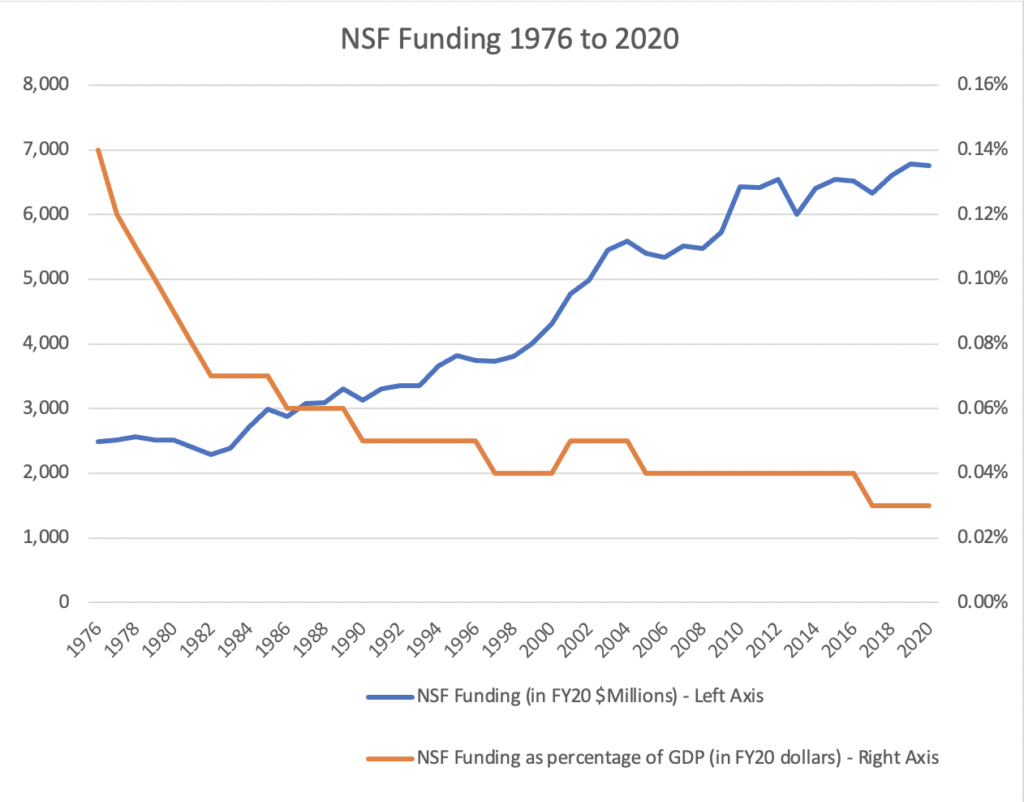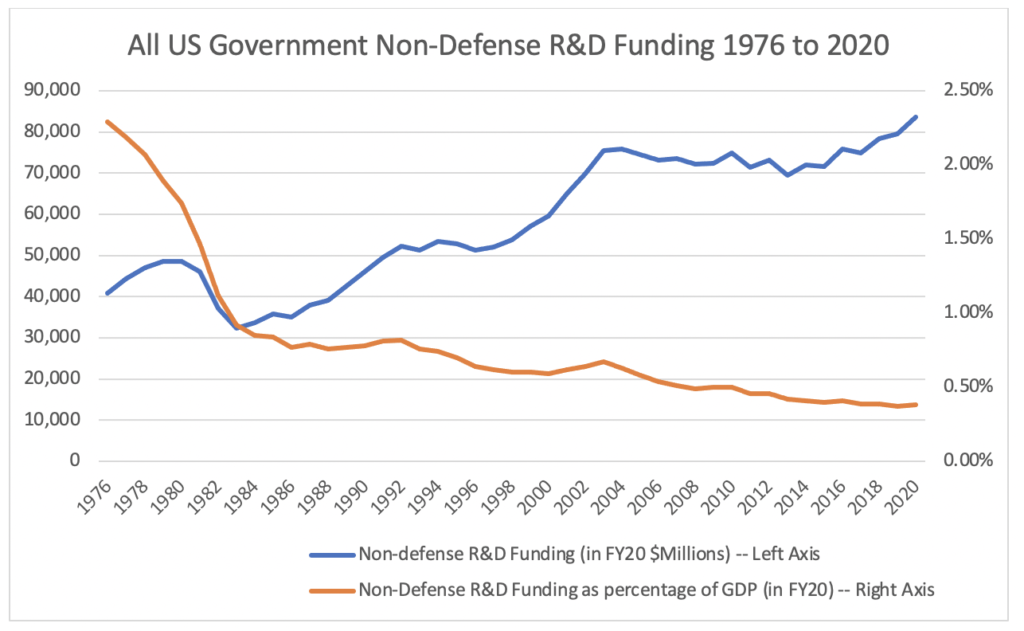Insufficient Funding of Science Infrastructure: A Continuing Concern
Will the System Collapse?
In December of 2020, an iconic science installation in Puerto Rico failed quite spectacularly (see a different view from a drone at the exact moment from above). This final collapse came after an initial cable snapped earlier this summer. The National Science Foundation’s Arecibo Observatory in Puerto Rico collapsed on December 1st, after elements of the support structure had broken in August. Not long after the initial damage, the NSF determined that it would decommission the radio telescope. Rather than waiting for humans to take care of business, physical forces, notably gravity, pushed the decommissioning project forward. What we witnessed isn’t simply the collapse of a single installation. Much as every story about sinkholes or video of collapsing bridges, the wreckage is emblematic of a much larger lack of financial support for our infrastructure. The primary cause of the failure of this research facility is the federal government’s tight-fisted approach to funding scientific infrastructure.
The installation was built in the 1960s at a projected cost of $9.3 million, equivalent to about $79.1 million today. In February 2018, the National Science Foundation — which has provided most of the observatory’s funding — announced that it would cut its annual contribution from $8 million to $2 million by FY2023. This was timed with a 26% reduction in the NSF budget for Major Research Equipment and Facilities in the two year period from FY2016 to FY2018. Of course, there are reasons why NSF might not want to continue to fund the operation of a 50-year old facility, but talk of decommissioning Arecibo apparently hadn’t been in the works prior to the most recent damage. In fact, investments in the facility had been underway for a number of years. The facility was damaged when Hurricane Maria hit Puerto Rico last year, but reopened quickly after the storm because of a $16.3 million repair investment. Following on that in 2018, a team of scientists received a $5.8 million grant to design and mount a supersensitive antenna at Arecibo, which was planned to be operational by 2022.
There are 33 large NSF Research Infrastructure Projects currently managed by the Large Facilities Office of NSF. There are four large projects under construction today for a total investment of nearly $1.6 billion. Several new initiatives are in various stages of multi-year development and build out, but the FY 2020 budget request for these investments was reduced by more than 20% from what had been allocated in FY2018. Managing a worldwide infrastructure for science is no small feat and this is not to cast aspersions on NSF, its team of dedicated staff, or the many, many teams that actually manage the science projects both large and small. However, over the years, as the number of facilities has grown and there continues to be investment in new facilities, overlaid on a relatively stable overall budget, obviously something had to give.
NSF Funding 1976 - 2020

Follow the Money
Overall, the US Federal government is spending far less on research and development funding, as a percentage of the economy, than it historically had done. Using data compiled by the AAAS, the NSF budget has generally increased in real terms from the 1980s, even accounting for inflation over this time, to approximately $7 Billion in 2020. Despite this growth in real terms, the NSF budget has decreased significantly as a percentage of the overall economy. NSF funding has decreased as a percentage of the US GDP from 0.14% in 1976 to less than 0.03% in 2020. With the overall U.S. GDP forecasted to be $21.1 trillion, if the budget for NSF were sustained at the 0.06% of GDP level budget at the end of the Reagan administration, after a decade of significant budget cutting, the budget would be $12.6 billion, nearly double what it invests today. I expect with those additional $6 billion per year, the NSF could have prevented the Arecibo telescope from collapsing and could have invested significantly in new science advances.
All Federal R&D Funding 1976-2020

Follow the Logic.
Sadly, this funding situation is consistent across all areas of non-defense research and development funding by the US Government. Overall non-defense R&D funding is only 16% of what it had been as a fraction of the US economic output in 1976. Compared to the entire economy, the NSF R&D investment as noted above is funded at a level that is just over one fifth of what it was back in 1976. The NIH has sustained its fraction of GDP better than other agencies, but even that is less than 40% of 1976 levels. Had NSF simply been able to maintain as NIH had, it’s budget would be roughly at its 1988 level relative to GDP and would be close to double what it is now. The same could be said for nearly every other major science funding arm of the government, NOAA, DOE, USDA, NASA, or the DOT. Again using data from AAAS, the trend of investment in research and development has shrunk from over 2.25% of national GDP in 1976 to just 0.38% today. The scramble for resources impacts the science that can be done, as well as the overall investments in the scholarly and research landscape as well, which includes libraries, publishers, and scholarly societies.
It is not simply NSF that is having trouble managing the costs of infrastructure. Also this month, the National Oceanographic and Atmospheric Administration (NOAA) announced that it is considering throttling back access to its data feeds, because the bandwidth demands during peak times around sever weather events are becoming overwhelming. Data access at peak times were bottlenecking its systems. Why a multibillion dollar agency cannot afford a scalable content distribution network (CDN) system to support the public’s bandwidth needs is astounding. While not trivial, the costs to support such a data network were estimated to cost in the range of $2-5 million per year; hardly unmanageable for an organization whose mission is to gather and distribute climate information. For example, a 4,000-TB/month-level service on Microsoft’s Azure CDN system would cost roughly $4 million per year – and that is quite a lot of data throughput, and of course Azure or Amazon’s AWS services can certainly scale beyond that. Today, distributing climate information is all about distributing data and to limit the agency’s ability to share data is certainly not in keeping with the direction of science or the public’s need for these resources. There is no reason to believe that data demands will diminish. As our ability to capture data increases, the ability to store data reduces in cost, and the demands from science and industry for data increase, we will need ever more robust infrastructure to create and share data.
Sadly, when it comes to funding the infrastructure to capture information, to process and then distribute it, the federal government is failing miserably. Whereas for decades, the US had been a leader in large-scale science infrastructure investments, these investments have been slowly decommissioned. The Arecibo observatory was the largest single radio telescope in the world until July 2016, when China finished the five-hundred-meter Aperture Spherical Telescope’s (FAST) giant dish. For years, the US was a leader in high-energy physics facilities. Until the Large Hadron Collider was built by the EU and began operating in 2008, the Tevatron at the Fermi National Accelerator Laboratory had been the world’s most powerful particle collider. The Tevatron was defunded in 2007 due to budget cuts, along with plans for a new particle accelerator in Minnesota, and was eventually closed permanently in 2011. While science is — and should be — a global endeavor, the long-time leadership of the US as the place for big science has been diminishing for some time.
What is most troubling about this is that there are myriad ways in which the funding infrastructure for science has untold ripple effects for society as a whole. For example, the practical impacts of the basic research into particle physics are wide ranging, from clinical oncology, ion implanters for manufacture of semiconductors, and radiocarbon dating technology. With the recent celebrated announcements related to the rapid development of several COVID-19 vaccines, we see the positive impacts of funding biomedical research can bring. The vaccines being produced this year are only in part the result of a flood of research money since the start of the pandemic in January. More important has been the decades of research that laid the groundwork for researchers to advance so quickly in their work. In part, this was because the investments in NIH funding hadn’t been slashed quite as badly as they had been in other research arms of the federal government. Had that foundational research not taken place, it might well have taken far longer to develop any therapeutics without the basic research funded by NIH and NIH grants.
It is worrying the focus on scientific successes this year might reinforce the notion that funding of science more broadly is functioning at an appropriate level. As evidenced by the recent science news that isn’t related to the pandemic, it obviously is not. Hopefully, those in positions of power to affect the national research funding agenda might look at the recent successes and failures and consider the value to increasing investments in basic research and reinvest in a science-based future.
